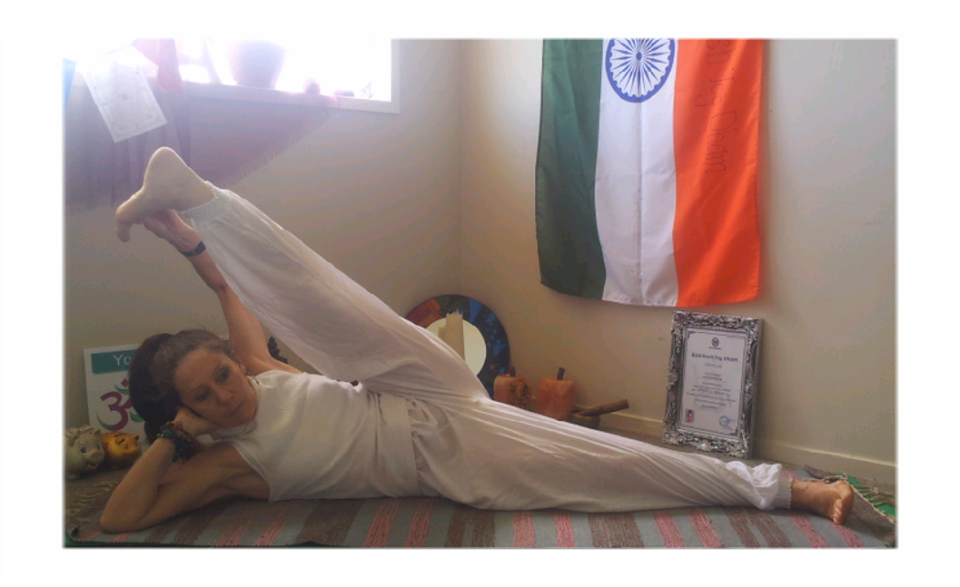Lord Vishnus Couch
Anantasana

Pronounced: Anan – TARS – anna
Sanskrit Meaning:
- Ananta = Infinite /Without end/Eternal
- Asana = Posture/Pose/Position
The myth is that Lord Vishnu reclined upon a couch that was infact the body of the serpent Ananta.
The story of Ananta is that of enernity the concept of infinity that which supports the timeless Universe.
Lord Vishnu is the mythological ‘Preserver’ and slumbers or sleeps unpon the coils of Ananta. The ideology is that Vishnu takes form on earth while life continues on then takes rest every 700 years or thereabouts upon the timeless coils of Ananta.
As yogi the idea is linked to the slumbering state or recline we all live in until our safety is threatened when we stir and rise up from our slumber.
Physically this is the link between the mind the spine and the parasympathetic nervous system. This pose facilitates the resting in peace that we need to consciously experience and from which our intuitive self is nourished and communed with, so knowing is profound. This is a place of inner and outer stillness and is restorative so we may be wholly nourished for the time we need to rise up off our couch in life.
To Move Into The Pose
Balance on your right side.. Lengthen through the right side of your body, from the hip crease to the armpit. Rest the right armpit into the floor.
Bend the right elbow. Support the right side of the head.
Stretch through the right leg extending the energy through the heel. Allow the right side to engage and open into the floor (earth).
Place the left leg on top of the right keeping it more relaxed.
Breathing into the sacrum on the exhalation draw the sacrum (tail bone) in. This is working into the core and engaging the lower diaphragm.
The Dristhi (or gaze point) is straight ahead at eye level.
Pause and breathe. Exhale to your tailbone. As you breathe in expand through skull and down the spine to the sit bones. See the breath as entering and exiting through the crown chakra and when your inhalation is complete imagine the area around the body is alight with this energy.
Bend the right knee.
Externally rotate the right leg from the hip socket and lift the left foot so you can catch the big toe. If you can not catch the leg where you can most comfortably.
Keep the top shoulder in line – stacked with the lower shoulder.
Exhale and straighten the left leg, while holding where you can – the toe if possible
Relax and allow the body to settle. As you breathe practice the sinuous movement of the breath from the tail bone (sacrum) through the vertebrae of the spine (as you have practiced in the pelvic tilt with abdominal breathing). The breath nourishes the spine and the earth supports the body.
With the breath in stretch, then as you exhale soften and settle and finally after 3-5 or more deep relaxing breaths come to a place of mental, emotional and physical stillness.
Experience unity or oneness with the Ananta, abiding peace, calm, infinite, eternal and unchanging.
Repeat on other side.
This pose is one to savour, not to rush!
Anatomy of Pose
This is an asymmetrical pose – considered one of the only true ‘side lying’ postures.
The upper leg:
Passively lengthening are the calf, hamstring and inner thigh muscles, active are the hip and core (soleus, gastrocnemius, gracilis, semimembranosus, semitendonsus, adductor magnus, psoas major, illiacus)
The lower leg:
Active are the quadriceps and gluts, Passive are the hamstrings (adductor longus, gracilis, pectinus, gluteus medius gluteus minimus, hamstrings).
The upper side:
Active are the abdominal wall, spinal extensors (internal obliques, quadrates lumborum)
The lower side:
Active are the abdominal wall, spinal extensors, core (external oblique, quadratus lumborum).
Physiology of the Pose
In this position the dome of the lower side of the diaphragm moves upwards towards the head and the upper side of the diaphragm moves towards the pelvis.
The lower side lung is supported and is more relaxed and responsive passively to the movement of the diaphragm with the breath.
The upper side is contracted thereby wringing the lung of stale air.
The pose relaxes the parasympathetic nervous system and facilitates cleansing of the lungs. It is reputed to assist in changing sleeping habits if one has a tendency to lie on one side more than the other.
|
Bibliography:
Leslie Kaminoff – Yoga Anatomy
https://yogainternational.com/article/view/the-mythology-behind-anantasana-vishnus-couch
http://www.yogajournal.com/article/practice-section/vishnu-s-repose/
http://www.yogananda.com.au/patanjali/yoga_sutras02.html#two
